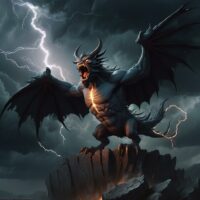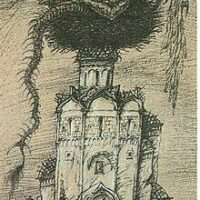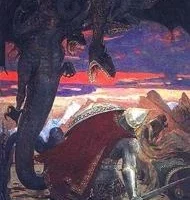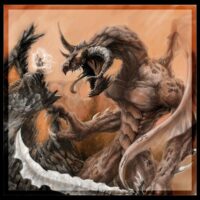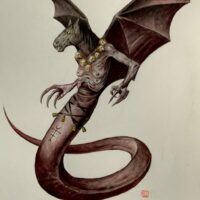Ala : The Weather Demon
Listen
At a glance
| Description | |
|---|---|
| Origin | Balkan Mythology |
| Classification | Hybrids |
| Family Members | N/A |
| Region | Bulgaria, Serbia, Macedonia |
| Associated With | Storms, Lightning, Weather |
Ala
Introduction
The Balkans, a region with a rich history and diverse cultures, also features a fascinating array of myths and legends. Among these is the Ala, a fearsome demon linked to destructive storms and the wrath of nature. This article delves into the chilling world of the Ala, exploring its physical characteristics, connections to other mythical beings, regional name variations, its terrifying powers, and its lingering influence in modern Balkan folklore.
In the complex tapestry of Balkan mythology, the Ala stands out as a formidable and enigmatic figure. Revered by some and feared by many, this female demon is intricately tied to the capricious forces of weather. The mythology surrounding the Ala is rich and diverse, reflecting the cultural influences of Slavic, Illyrian, and Thracian traditions.
Physical Traits
The appearance of an Ala is as varied as the tempests she commands. Folklore depicts her in numerous forms: a black wind, a massive creature with indistinct features, a monstrous human-like or snakelike being, a female dragon, or even a raven. She can seamlessly shift between human and animal shapes, and rumor has it that she can even possess a person’s body. The Ala’s physical form remains mysterious, with variations depending on the region and the storyteller. Some accounts describe it as a monstrous winged creature, resembling a giant bird or a grotesque dragon. In Bulgaria, the “Hala” often has immense wings and a tail sharp as a sword. Conversely, Serbian folklore portrays the Ala as a formless entity, a swirling vortex of darkness embodying the storm’s fury.
Intriguingly, some legends describe the Ala as a shapeshifter, capable of morphing into various forms. She might appear human-like, disguised as a beautiful woman to lure unsuspecting victims. In other tales, she could take the form of a terrifying beast, striking fear into the hearts of men. This shapeshifting ability underscores the Ala’s unpredictable and deceptive nature, enhancing her nightmarish reputation.
Family
In Ala mythology, her lineage or family structure is not consistently defined, a common trait in many mythological traditions where such figures often stand alone as embodiments of natural forces. However, in some stories, Ala is mentioned alongside similar mythological beings. For instance, she is sometimes considered a sister or close relative to other weather-related spirits or demons, such as the Slavic Zmey (a dragon-like creature) or the Romanian Balaur (a multi-headed dragon). In other tales, Ala is associated with the gods and goddesses of Slavic mythology, particularly those connected to the elements and the natural world. In these contexts, she might be seen as a subordinate or servant to more powerful deities who command the weather and seasons. Unlike some mythological creatures who belong to complex pantheons, Ala appears to be a solitary entity. There are no documented accounts of an Ala family or a hierarchy within these demonic beings. This isolation reinforces her role as a single-minded force of destruction, driven by a relentless urge to unleash chaos upon the land.
However, some scholars suggest a possible connection between Ala and other mythical figures. Notably, the Balkan dragon, the Zmeu (or Zmaj), is often seen as a benevolent creature, a protector against malevolent forces. Some legends depict the Zmeu battling Ala, driving away the storm demon and safeguarding the crops from hail. This potential association hints at a larger mythological framework where Ala represents a disruptive element countered by a force for good. While some mythological beings span across all Slavic ethnic groups, Ala seems exclusive to Bulgarian, Macedonian, and Serb folklore. Her origins remain shrouded in mystery, but she shares similarities with both Slavic demons of bad weather and pre-Slavic demons from the central Balkans. Perhaps she is a synthesis of these ancient forces, bridging the gap between worlds.
Other names
The name “Ala” predominates in Bulgaria, Macedonia, and Serbia, yet this formidable storm demon manifests under diverse identities throughout the Balkans, reflecting the region’s rich cultural diversity. In Slovenia, it assumes the guise of “Krt” or “Krampus,” a monstrous entity linked to winter storms and retribution. Similarly, the Polish “Zmora” shares traits with Ala, embodying nightmares and sleep paralysis.
These regional variations suggest that Ala embodies a universal concept—the destructive force of nature personified. While specific details may vary, the core theme of a fierce entity wielding storm-related powers resonates across Balkan cultures. Known by different names across the Balkan region, Ala is referred to as “Ala” in Serbian and Croatian folklore, while in Bulgarian mythology, she is “Hala.” Albanian tradition identifies her as “Ora” or “Ora e keqe,” meaning “evil hour” or “evil fate,” emphasizing her association with ominous signs and disasters.
In some areas, Ala is linked with other mythical beings sharing similar attributes, such as the Greek Lamia, a child-devouring demon, or the Russian Baba Yaga, a fearsome witch. These diverse names and identities reflect the widespread and multifaceted nature of Ala’s mythology, as well as her integration into various cultural narratives. Additionally, Ala is known by various names including Aletina, Alina, Alosija, Alčina, and Hala, each echoing her power through the storm clouds and across the haunted fields.
Powers and Abilities
The Ala’s main powers are closely associated with her role as a weather demon, with control over storms, hail, and other destructive weather phenomena. Often considered a harbinger of natural disasters, she is blamed for crop ruin, droughts, and misfortune. Her presence is marked by sudden and severe weather changes, including dark clouds, thunder, and lightning. Among her feared abilities is the capacity to devour the sun or moon, causing eclipses and symbolizing her power to disrupt the natural order. Communities perform rituals to drive her away and restore balance.
Known for her cunning and deceptive nature, she can shapeshift to trick victims, often appearing as a beautiful woman to ensnare unsuspecting men. Despite her malevolence, some stories suggest she can be appeased or controlled through rituals or offerings, reflecting the complex relationship between humans and nature. Additionally, the Ala wields influence over skies, clouds, and storms, leading hail-producing thunderclouds to devastate crops. Legends even suggest she may attempt to devour celestial bodies, potentially heralding apocalypse. Encountering her poses risks, yet approaching with respect may lead to prosperity and protection.
Modern Day Influence
The Ala remains a prominent figure in Balkan folklore and cultural memory, with proverbs like “strong as an Ala” reflecting its enduring legacy of immense strength. Traditional rituals persist in some regions to ward off the Ala and protect crops from hailstorms, emphasizing the continued belief in its destructive power.
Moreover, the Ala’s influence extends to modern Balkan literature and art, where writers use it as a metaphor for both natural and man-made destructive forces. Artists depict the Ala in paintings and sculptures, capturing its fearsome visage and reminding viewers of its significance in Balkan mythology. Despite being rooted in ancient folklore, the Ala’s legacy persists. In contemporary times, eagles are revered in the Balkans as defenders against the Ala’s wrath, symbolizing protection from hail clouds gathering overhead. As society evolves, the Ala serves as a reminder of humanity’s delicate balance with nature.
In summary, the Ala, a storm demon with insatiable hunger, exerts influence over the elements, evoking both awe and trepidation. Its story intertwines with Balkan mythology, showcasing the enduring power of ancient beliefs. In modern times, references to the Ala abound in literature, art, and popular culture, symbolizing nature’s uncontrollable and destructive forces, as well as the ongoing struggle between order and chaos.
Related Images
Frequently Asked Questions
What is lorem Ipsum?
I am text block. Click edit button to change this text. Lorem ipsum dolor sit amet, consectetur adipiscing elit. Ut elit tellus, luctus nec ullamcorper mattis, pulvinar dapibus leo.
What is lorem Ipsum?
I am text block. Click edit button to change this text. Lorem ipsum dolor sit amet, consectetur adipiscing elit. Ut elit tellus, luctus nec ullamcorper mattis, pulvinar dapibus leo.
What is lorem Ipsum?
I am text block. Click edit button to change this text. Lorem ipsum dolor sit amet, consectetur adipiscing elit. Ut elit tellus, luctus nec ullamcorper mattis, pulvinar dapibus leo.
What is lorem Ipsum?
I am text block. Click edit button to change this text. Lorem ipsum dolor sit amet, consectetur adipiscing elit. Ut elit tellus, luctus nec ullamcorper mattis, pulvinar dapibus leo.
What is lorem Ipsum?
I am text block. Click edit button to change this text. Lorem ipsum dolor sit amet, consectetur adipiscing elit. Ut elit tellus, luctus nec ullamcorper mattis, pulvinar dapibus leo.

